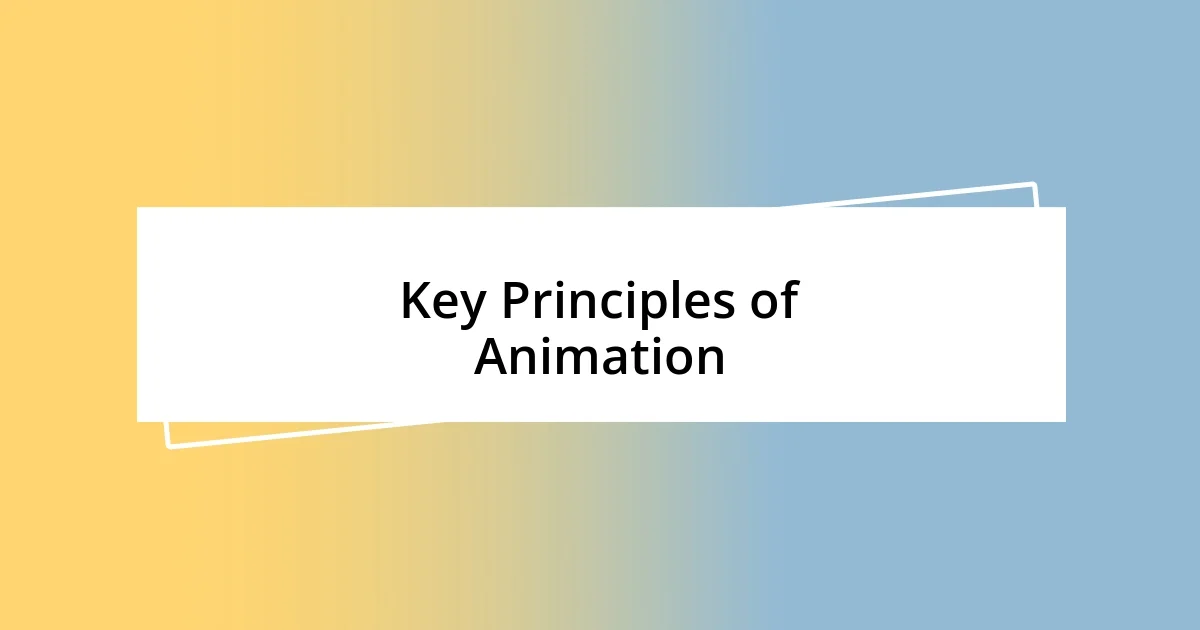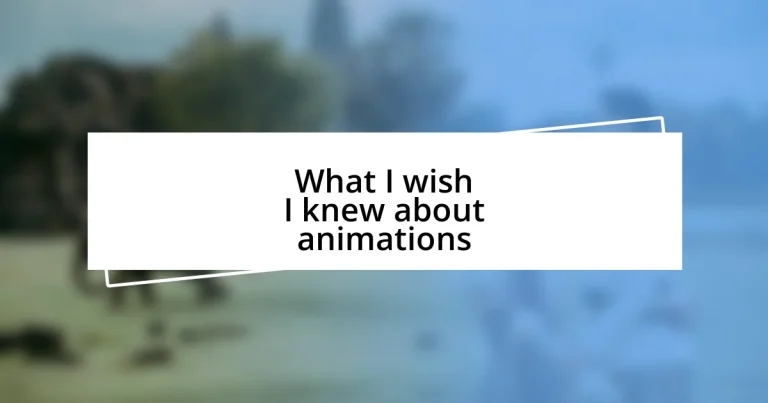Key takeaways:
- Understanding the fundamentals of animation, such as timing, spacing, and storytelling, is crucial for creating fluid and engaging animations.
- Key techniques like keyframing, squash and stretch, and effective animation loops add depth and realism to animated movements.
- Regular practice, seeking feedback, and utilizing online resources can significantly enhance one’s animation skills and creative journey.

Understanding Animation Basics
When delving into animation basics, it’s vital to grasp the principles of movement. I remember my first attempt at creating an animated character; I was so excited, yet I quickly learned that capturing fluid motion requires a deep understanding of timing and spacing. Have you ever noticed how a character’s walk can convey their personality? That’s all about the nuances of movement!
Another key element is the concept of frames. I still recall the thrill of seeing my drawings come to life, but it was daunting to realize that each second of animation often consists of 24 frames! This means that every little detail matters. Have you ever sat down to watch a simple animated sequence and wondered how much effort went into each frame? It’s a labor of love that truly pays off in the end.
Lastly, let’s not overlook the importance of storytelling. I genuinely believe that animation is not just about pretty pictures; it’s about telling a compelling story. My early animations felt flat until I started focusing on narrative arcs. Think about your favorite animated film—doesn’t the way the story unfolds enhance your connection to the characters? Great animation weaves the visual and the narrative into a seamless experience.

Common Animation Techniques
When exploring common animation techniques, one can’t overlook the charm of keyframing. My first experience with this technique was quite eye-opening. I remember distinctly placing keyframes at important stages of movement and watching my animations transform from static to dynamic. Keyframing is all about defining start and end points for movement, while the software fills in the gaps. Isn’t it fascinating how this simple concept can lead to such a range of expressive motions?
Another technique I embraced early on was squash and stretch. This principle adds life and realism to animations; it’s something I wish I had understood from the beginning. Picture a bouncing ball. When it hits the ground, it squashes down, and as it bounces back up, it stretches. Some of my earliest projects lacked this flair, and they felt lifeless. Once I incorporated squash and stretch, my animations radiated energy, capturing the attention of my friends and family, and even making them chuckle!
Let’s not forget about animation loops. I’ve discovered that effective looping can create a mesmerizing rhythm in a scene. Initially, I struggled to make my loops seamless, but with practice, I learned how to choreograph movements that felt alive. Have you ever watched a character dance in a loop and felt entranced? It’s the mastery of timing that transforms a mere sequence into something captivating.
| Animation Technique | Description |
|---|---|
| Keyframing | Defining start and end points for movement. |
| Squash and Stretch | Adds realism by showing weight and volume changes during motion. |
| Animation Loops | Creating repeating sequences to give a sense of rhythm. |

Essential Animation Software Tools

Essential Animation Software Tools
Choosing the right animation software can significantly impact your creative process. In my early days, I tried various tools, each with a unique feature set that gave me a distinct flavor of animation. I still vividly remember the exhilaration of discovering Adobe After Effects. It’s so customizable and powerful that I found myself lost in endless possibilities, crafting scenes I once thought were beyond my reach. The moment I realized I could blend visual effects with animation opened a whole new realm for storytelling. Have you ever felt that rush when everything just clicks? That’s what the right software can do for you!
- Adobe After Effects: A powerhouse for creating intricate animations and visual effects, perfect for both beginners and professionals.
- Toon Boom Harmony: An industry favorite for hand-drawn animations, it holds a special place in my heart for its smooth workflow.
- Blender: Open-source and incredibly versatile, it allows for 3D animations without breaking the bank. I remember diving deep into its features and being amazed at how much I could create for free!
- TVPaint Animation: This tool is fantastic for traditional 2D animation. It helped me refine my drawing skills while enhancing my character designs.
Each software has its strengths, and experimenting can lead to surprising discoveries about your own style. I initially chose software based on what I thought I needed, but over time, I realized that my creative voice was developing alongside my toolkit. Finding the right balance can be a journey—don’t rush it! Just think about when you finally nail down your favorite brush or color palette; that satisfaction feels incredible, doesn’t it? The right software can provide that feeling of empowerment while shaping your artistic journey.

Tips for Improving Animation Skills
Diving deeper into improving animation skills, one of the most valuable tips I’ve discovered is to study motion in the real world. I remember sitting in a park, just watching children play. Their movements—the way they ran, jumped, and fell—were a treasure trove of inspiration. Observing how everyday actions happen in life can uncover nuances that make your animations more believable. Have you ever noticed how a dancer shifts their weight mid-leap? Such observations can help you bring the same fluidity to your own work.
Another crucial aspect is to gather feedback regularly. Early in my animation journey, I was hesitant to share my work, fearing criticism. However, when I finally opened up, I received insights that transformed my animations. Constructive feedback from peers or mentors has been invaluable for refining my technique and enhancing storytelling. Have you ever experienced a moment where someone pointed out something you completely overlooked? That realization can be a real eye-opener, leading to breakthroughs in your craft.
Finally, practice makes perfect—but it doesn’t have to be monotonous. I often mixed routine exercises with personal passion projects. For instance, I’d spend a day animating a favorite cartoon character in a new scenario just for fun. This blend of discipline and enjoyment not only honed my skills but also reignited my passion every time I felt burnt out. How do you keep your creative spark alive? Finding those moments of joy, even within the structure of practice, is essential for long-lasting motivation in animation.

Key Principles of Animation
Understanding the key principles of animation is like uncovering the secrets behind a magician’s tricks. One principle that profoundly impacted my work is squash and stretch. It gives a character’s movement a sense of weight and flexibility. I remember animating a bouncing ball for the first time; when I added squash at its lowest point and stretch as it soared upward, it instantly felt alive. It’s this kind of attention to detail that can elevate even the simplest animations. Have you ever noticed how a cartoon character’s expression can change entirely with just a slight adjustment to their shape?
Another fundamental principle is anticipation, which prepares viewers for an action. It might seem subtle, but I’ve seen how it can make or break a scene. I recall a time when I animated a character about to leap into the air. By including a crouch before the jump, I noticed how it heightened the excitement. It’s a small step, but it adds so much depth to the animation. Ask yourself, how often do you skip this crucial moment in your animations? Realizing its importance has made my work more engaging and dynamic.
Lastly, I can’t stress enough the significance of timing and spacing. These elements create fluidity and believability in action. In my early projects, I often underestimated how timing impacted the pace of my animations. Then, during a particular project, I experimented with varying the frame rate on a running character. Watching that sprint transform from sluggish to vibrant was an epiphany for me. Timing feels like the heartbeat of animation—what’s your experience with finding the right tempo in your work? It often takes practice, but once you master it, your animations will dance to life in ways you never thought possible.

Avoiding Common Animation Mistakes
One common mistake I see many animators make is neglecting the importance of storyboarding. In my early days, I would jump right into animating without a clear plan, thinking I could figure it out as I went along. I quickly learned that this approach often led to muddled narratives and disjointed sequences. Have you ever watched an animation that felt like it was missing pieces of the puzzle? Storyboarding gives you that blueprint to visualize the flow of your story, allowing you to catch inconsistencies before they become a headache in the editing room.
Another pitfall is overcomplicating animations with excessive movement or details. I remember a project where I tried to cram every possible action into one scene, believing it would showcase my skills. Instead, it felt chaotic and overwhelming for viewers. Simplifying your animation can often be more effective—removing unnecessary elements keeps your audience focused and engaged. Have you ever found that less truly is more in your work? Understanding what to emphasize can make your storytelling much clearer.
Lastly, timing can often be an overlooked aspect of animation that leads to clunky results. I fell into the trap of animating certain actions too quickly or too slowly, losing the natural rhythm. After experimenting with different pacing, I began to appreciate how crucial timing is to convey emotions effectively. Think about how a pause can add tension—have you tried testing your animations at different speeds? Finding that sweet spot will help your audience feel genuinely connected to the characters and their journeys.

Resources for Further Learning
When diving deeper into animation, I often turn to online platforms like Skillshare and Udemy. These courses have been a game-changer for me. They not only provide structured lessons from industry professionals but also allow me to learn at my own pace. Have you ever wished for a mentor? These platforms feel like having one right at your fingertips; it’s an incredible resource for both beginners and seasoned animators alike.
I’ve also discovered the wealth of knowledge available in books like “The Animator’s Survival Kit” by Richard Williams. This book is often regarded as the bible of animation for a reason! I remember flipping through its pages during late-night study sessions, feeling both inspired and overwhelmed. Each principle discussed felt like unlocking a new level in my animation journey. Have you explored any titles that sparked your creativity? The right book can challenge your perspective and push your skills to the next level.
Additionally, YouTube is a treasure trove of animation tutorials and behind-the-scenes insights. I often find myself lost in a sea of videos, watching everything from quick tips on character design to in-depth breakdowns of animation software. Sometimes, I stumble upon an unexpected gem; I once watched a tutorial on using sound effectively in animations, which opened my eyes to its crucial role. What about you—have you found that one video that completely shifted your approach? It’s these small moments that can make a significant impact on your craft.













